Michigan is one of the states with hundreds of types of caterpillars across trees, shrubs, grasses, and vegetables.
Various moth or butterfly caterpillars are common across hardwood trees in forests and open areas. Caterpillars are also found in high numbers on willows across the state.
Some caterpillars feed on the leaves of fruit trees such as apple trees or cherry trees.
Caterpillars in Michigan show similar feeding habits to those in other states. They can even show mimicry tactics that help them keep predators away.
Some of these caterpillars are known for resembling bird droppings, wasps, or even small snakes. All of these efforts are considered for staying safe from predators such as birds.
Some caterpillars in Michigan even build small silk nests on the leaves they consume. This protects them against other types of predators such as spiders.
The following species of caterpillars are mostly found in Eastern US states and Michigan. Most of them have very specific host plants they feed on.
Table of Contents
1. Monarch Caterpillar

The Monarch caterpillar (Danaus plexippus) is one of the most common species of caterpillars in the state of Michigan.
The commonality of the species has a lot to do with its habitat but also its coloring as these caterpillars have contrasting body colors that help them keep most predators away.
This contrasting coloring includes a striped body. Black and white stripes are seen across its body together with yellow dots.
Monarch caterpillars feed on milkweed and they can extract the toxins in the plant which they stored in some parts of their body.
Only the best predators know where these toxins are in the body of the caterpillar. They avoid eating these parts of the body.
The toxins stored by these caterpillars have little impact on predators apart from the bad taste.
2. Spongy Moth Caterpillar

Michigan is one of the states with thousands of tree species. This is to the advantage of Spongy Moth caterpillars (Lymantria dispar) which are known to feed on at least 300 species of trees.
These caterpillars eat the leaves of various trees at night.
They go through several instars and finally develop into a gray, black, and red caterpillar in the last instar.
These caterpillars can be troublesome for trees as they can skeletonize entire leaves.
The size of the Spongy Moth caterpillar is comparable to other common caterpillar sizes in Michigan.
Male caterpillars reach a size of up to 1.5-1.7 inches while females are larger and grow to a size of at least 2.5 inches.
3. Red-spotted Admiral Caterpillar

Red, white, and black coloring is specific to the Red-spotted Admiral caterpillar (Limenitis arthemis).
Unlike adults of the species, caterpillars are dominated by a red-brown color. This is a type of color that may not keep as many predators away as the highly contrasting colors of the Monarch caterpillar.
The adult Red-spotted Admiral is known for eating fruits. Its caterpillars eat a wide range of leaves in fruit-bearing trees being a threat to consider in gardens.
Red-spotted Admiral caterpillars live on and eat different tree leaves depending on their region in the country.
Most caterpillars of this species like to eat aspen leaves. But there are many exceptions to these caterpillars only eating other types of leaves.
Red-spotted Admiral caterpillars feed on yellow birch trees when living in the Northern US states.
Caterpillars living in Southern territories like to eat the soft leaves of cherry trees.
It has also been shown that Red-spotted Admiral caterpillars living in the South may also eat the leaves of flowers apart from tree leaves.
The green leaves of various roses are a good alternative food source for the caterpillars in this region.
4. Black Swallowtail Caterpillar

As the Monarch caterpillar, the Black Swallowtail caterpillar (Papilio polyxenes) also has striking colors.
This species has bright green coloring with multiple black stripes. These black stripes also show small yellow dots across.
Black Swallowtail caterpillars are an invasive species on parsley.
You may encounter them in your garden if you have a significant amount of parsley to attract these caterpillars.
Black Swallowtail caterpillars have a few methods of keeping predators away. Coloring and bad taste are among them.
The caterpillar absorbs toxins in plants it feeds on so that it has a very bad taste to predators.
Even more, the Black Swallowtail caterpillar is one of the species in Michigan that can go as far as releasing a bad repelling smell whenever predators approach.
5. Isabella Tiger Moth Caterpillar

Michigan is not known for its warm weather. Caterpillars found here deal with temperate and cold weather well.
The Isabella Tiger Moth caterpillar (Pyrrharctia isabella) is one of those species that can deal with extreme temperatures, even below the freezing line.
The natural habitat of the species spreads far North from Michigan.
Isabella Tiger Moth caterpillars can even survive winters in Alaska.
They can freeze in the ground during the winter to come back to life in the spring.
Caterpillars of this genus have a cryoprotectant substance that ensures vital organs aren’t affected by freezing even if their heart stops beating in the winter.
These caterpillars are identified by a dark red and black body with long setae.
Isabella Tiger moth caterpillars don’t cause an allergic reaction when touched and they don’t carry toxins either.
It’s their long setae that can be painful whenever these caterpillars are handled with bare hands.
6. Hickory Tussock Moth Caterpillar
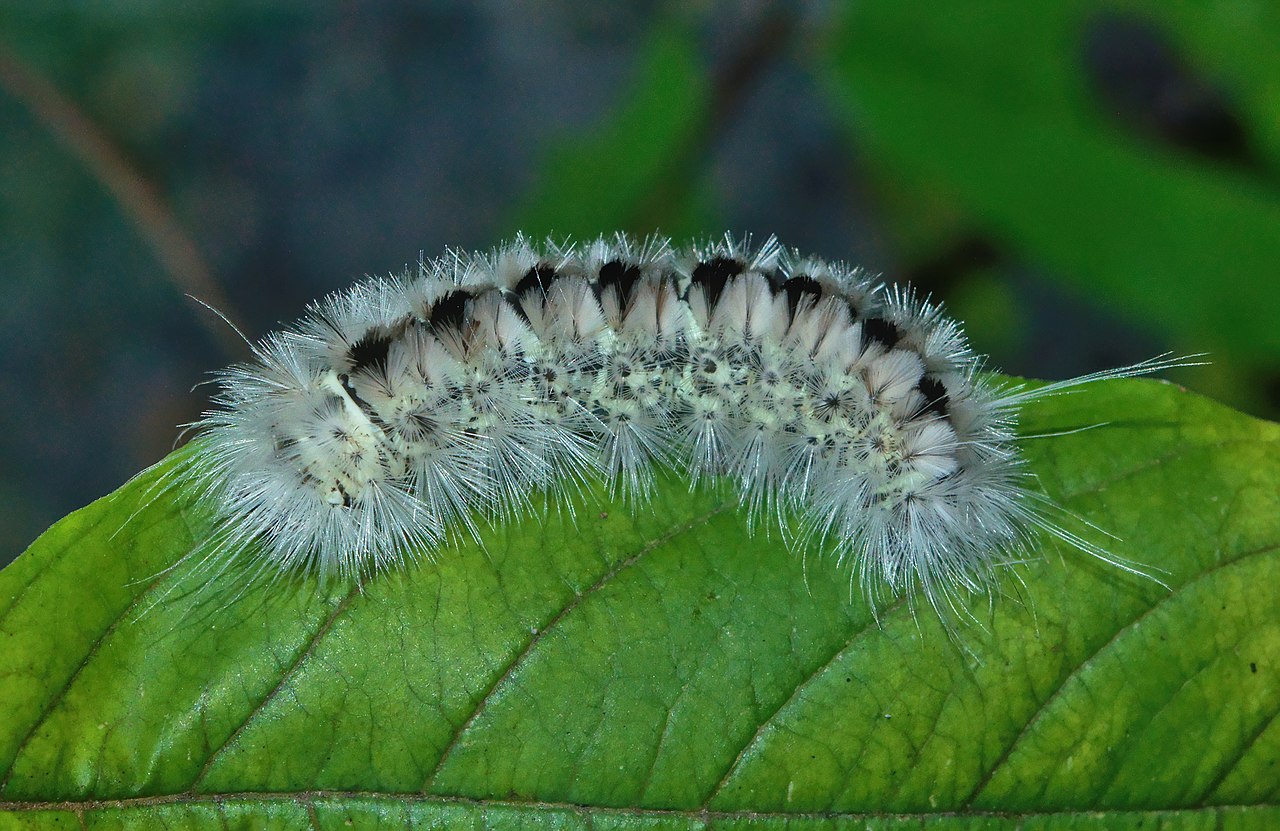
As its name implies, this caterpillar (Lophocampa caryae) is common on hickory.
It has adapted to eating the leaves of other species as well, particularly walnut. Almost all hickory and walnut trees in Michigan are vulnerable in front of this caterpillar.
The biggest threat to these trees is when these caterpillars are among their first instars as they tend to feed together in groups.
Hickory Tussock Moth caterpillars start to become solitary as they approach late instars which also diminishes their impact on hickory.
Caterpillars of the specie shave a gray and black body covered in sharp irritating hairs.
Your skin can start to tingle whenever you handle these caterpillars. People with allergies can even start having more severe symptoms such as red skin and constant itching.
It’s best to avoid touching Hickory Tussock Moth caterpillars to stay away from the skin issues they can cause in humans.
7. Cabbage White Caterpillar

Almost all cabbage crops in Michigan can suffer from an invasion of the Cabbage White caterpillar (Pieris rapae). This is a species that exclusively feeds on crucifers such as cabbage.
The caterpillar is considered a pest in the state.
Cabbage White caterpillars might not be visible on cabbages at first. They always hide on the underside of cabbage leaves which makes them impossible to spot predators moving above the cabbages such as birds.
The caterpillars are initially black. They then start to brighten as they move towards the last instar.
Caterpillars of this genus start to become yellow to settle to a bright green color which resembles the color of classic cabbages.
This species is diurnal. Cabbage White caterpillars only move for more cabbage during the day preferring to rest at night.
You can find these caterpillars to be very active up until mid-summer. They are considerably less active on the hottest summer days.
8. Milkweed Tussock Moth Caterpillar

Milkweed Tussock Moth caterpillars (Euchaetes egle) are a type of colorful caterpillar also common in Michigan.
As the name implies, the species feeds on milkweed. It also feeds on dogbane whenever there’s no suitable milkweed to feed on.
If most caterpillars that are social are only social in their first instars, the Milkweed Tussock Moth caterpillar is initially solitary in its first instars.
It starts to become social and to feed in groups as it approaches the late instars or growing stages.
The species has a final orange and black coloring with long setae which make it deter almost all known predators.
9. Mourning Cloak Caterpillar

Mourning Cloak caterpillars (Nymphalis antiopa) live together in small groups in their first instars.
These caterpillars start to feed independently as they grow in the last instar.
They are often seen on various species of willow across the state. Wild rose and hackberry are also among the host species Mourning Cloak caterpillars like to feed on.
It’s the sap of these trees that the caterpillars are interested in.
On occasion, these caterpillars also eat the honeydew aphids produced on willows.
Mourning Cloak caterpillars have a gray-white body. They show multiple black stripes along the body together with small deterring red dots.
Caterpillars of this genus are completely covered in gray or black hairs.
As they reach the final instar, Mourning Cloack caterpillars measure up to 2 inches.
10. Eastern Tiger Swallowtail Caterpillar

Eastern Tiger Swallowtail caterpillars (Papilio glaucus) are brown in their first instars. They turn green just before pupation.
This caterpillar is brown most of its life. This coloring is mimicking bird droppings. This makes it a lesser target for many birds and wasps that visit magnolias and other flowers it lives on.
Caterpillars of this genus are highly common in gardens where they see various decorative flowers as hosts.
They also live up on trees where they have sufficient leaves to feed on.
Magnolias and rose flowers are among the most common hosts of the Eastern Tiger Swallowtail.
This species prefers the smaller leaves of these flowers.
However, the species continues to thrive even in areas without magnolias or roses, always falling back on willow as a backup host.
Ash, cottonwood, and lilac are all alternatives to roses and magnolias as well.
11. Silver-spotted Skipper Caterpillar

The Silver-spotted Skipper caterpillar (Epargyreus clarus) has a diverse diet and habitat, just like the adult of the species.
If the adult sometimes prefers to eat animal feces, the caterpillar of the species only concentrates on the trees and shrubs that offer leaves with good nutrition.
As a result, this caterpillar lives on a wide range of trees. It prefers those in the pea family but it’s adapted to some of the most common trees in urban gardening such as wisteria as well.
Often seen on the American hogpeanut, this species is also among the caterpillars that also feed on a wide range of legumes.
The short season of vegetables allows this species to adapt to the trees it also feeds on for a longer feeding interval.
Silver-spotted Skipper caterpillars are widely common across the US. Except for The Rocky Mountains, this species is seen in all territories including Canada.
12. Red Admiral Caterpillar

The Red Admiral caterpillar (Vanessa atalanta) has a wide US presence and it’s a common sight in Michigan.
Red Admiral Caterpillars are mostly black with long black hairs. It has an average size of around 1 inch and it’s one of the species with a considerable coloring variation in low-temperature summers.
Otherwise, the caterpillar remains black and it’s seen on various species of nettle, particularly stinging nettle.
This is a plant species native to Europe with a considerable world distribution.
Known for its stinging hairs, this plant acts as a defense mechanism for the caterpillar which isn’t seen as good prey by many predators.
The caterpillar further influences the aspect of the adult after pupation. Red Admirals are mostly black, with white and red margins.
13. Herald Moth Caterpillar

The Herald Moth caterpillar (Scoliopteryx libatrix) looks completely different from the moth adult.
The moth is brown and gray while the caterpillar is green.
Herald Moth caterpillars have a uniform green color. The coloring of the body is consistent across the instars of the species.
Caterpillars of this genus aren’t seen in Michigan gardens as they only live on trees and in the woodlands.
Willows are among their favorite trees. The fact willows grow next to water means they have leaves with plenty of nutrients.
Herald Moth caterpillars also live on poplar. As a result, the caterpillar is a common sight in Northern Lower Michigan.
14. Banded Tussock Moth Caterpillar

The Banded Tussock Moth caterpillar (Halysidota tessellaris) is one of the species with long yellow bristles found in the state.
Its bristles cover its entire body making it difficult to identify for some of its predators while others stay away from it to avoid the long bristles.
Caterpillars of this genus are also known to eat decaying plants and have toxins that keep predators away.
These toxins are absorbed by the caterpillar and its bristles. People touching the Banded Tussock Moth caterpillar may experience skin irritation.
15. Polyphemus Moth Caterpillar

The Polyphemus Moth caterpillar (Antheraea polyphemus) is the larvae of one of the largest moths in North America.
Caterpillars of this genus are among the few which may take up a different pose to ward off predators. They use the Sphinx position to deter possible enemies.
It’s believed this position makes them look less like caterpillars which makes predators move away.
The species has a vivid green body with tiny red spots which also act as a protective layer as it may make the caterpillar look poisonous.
This species of caterpillars live on many types of trees.
Some of these trees are heavily impacted by their presence while others aren’t.
Plum trees are among the most affected species by the Polyphemus Moth caterpillar.
16. Virginia Ctenucha Moth Caterpillar

This species (Ctenucha virginica) is one of the largest moths in Michigan. Its caterpillar undergoes color changes as it moves through instars.
Caterpillars of this genus are white and yellow initially. They then become black with white lateral stripes and long bristles.
You can see these caterpillars on various grasses across the state.
17. American Dagger Caterpillar
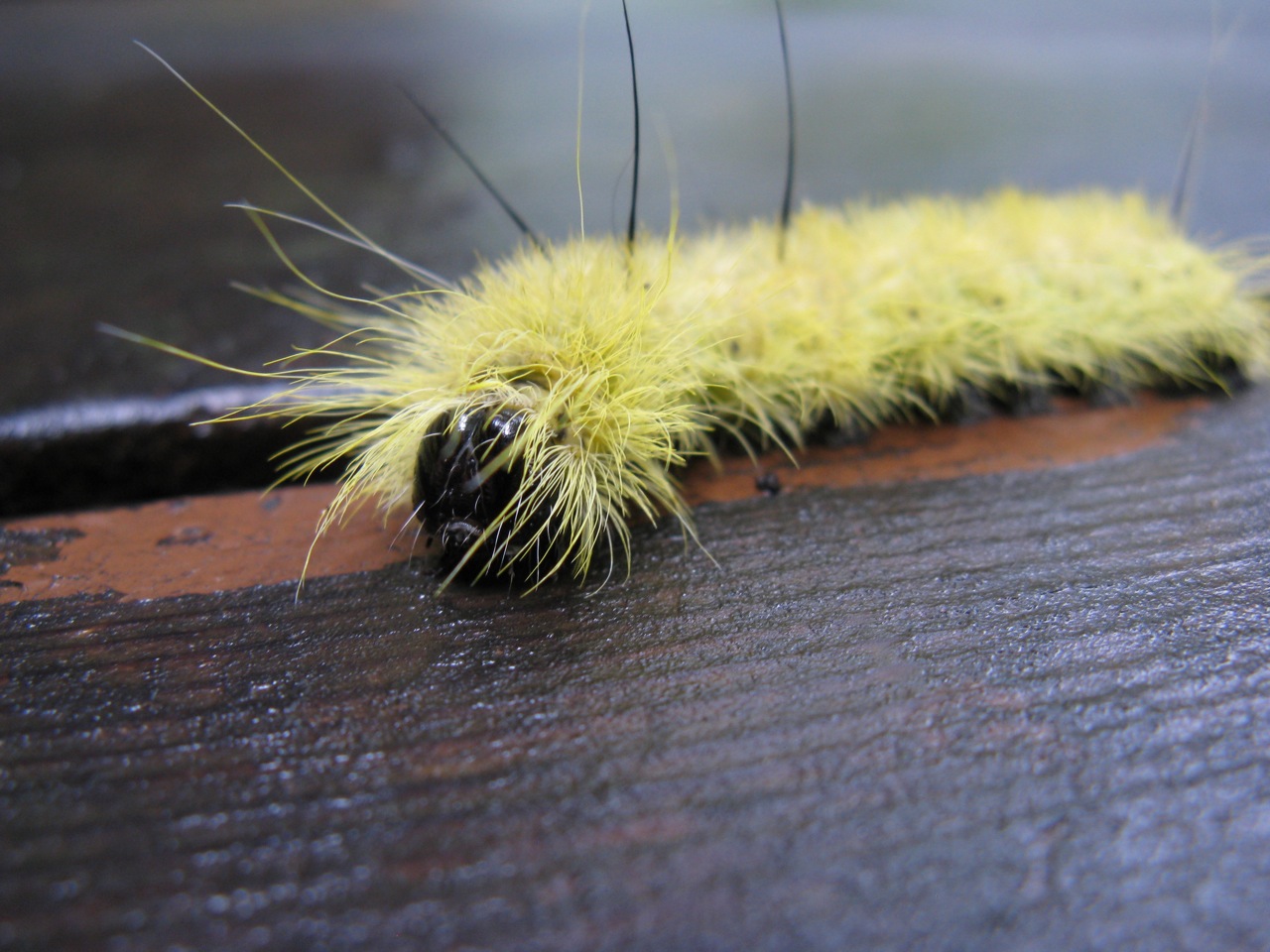
Growing to a size of up to 1 inch, the American Dagger caterpillar (Acronicta americana) has a distinct bright yellow color. Its body is covered in fine yellow hairs.
A few long black hairs are also visible in this species. It’s these hairs that cause skin reactions and why it’s best to avoid the species.
There’s no official data on the irritating nature of these hairs. However, some people report suffering from itchy skin after touching this caterpillar.
The colorful species is a common sight in Michigan forests. It’s also a common sight around riverbanks and lakes as the American Dagger caterpillar likes to live and eat willow leaves.
18. Pearl Crescent Caterpillar

The caterpillar of Pearl Crescent (Phyciodes tharos) has a high resemblance to the adults. This species has a brown and black color and even shares some of the host plants adults visit.
Pearl Crescent caterpillars are most common in the Eastern side of the US and this includes Michigan.
This species of caterpillars are seen on a wide range of asters, perennial flowers found in the state.
Frost asters are the host species most popular with the Pearl Crescent caterpillar. This species is found all around the state.
Caterpillars of this genus eat the leaves of these flowers and then move on to other flowers as adults but still visit asters even as adults.
Multiple broads can appear per season as the Pearl Crescent caterpillar has a long season.
It starts to become active in April and it remains active until November.
19. White-marked Tussock Moth Caterpillar

These types of caterpillars (Orgyia leucostigma) have a unique appearance compared to other common species in Michigan.
White-marked Tussock Moth caterpillars have 4 white defensive glands which aren’t covered in setae like the rest of the body.
Nobody knows for sure what the purpose of these white glands is.
Some suggest these glands are used to mimic wasp cocoons while others say the glands have the role of improving camouflage while on the host plant.
These caterpillars have a striped body. Red, black, and yellow stripes are common on the species.
You can further distinguish the bristles on the body which are white or black.
Touching the White-marked Tussock Moth caterpillar isn’t the brightest idea. You may end up having to use cooling ice as the bristles of the species cause mild skin irritation.
20. Spicebush Swallowtail Caterpillar

Spicebush Swallowtail caterpillars (Papilio troilus) live and feed on laurel plants. This genus of plants comes with small or large green leaves these caterpillars eat completely, including the veins.
Apart from feeding on laurel, the Spicebush Swallowtail caterpillars are also known for having a mimicry-inclined appearance.
These caterpillars are yellow first. They then turn brown to finally become partially green and partially brown.
Uniform green dominates the dorsal area while the ventral area is light brown.
Small blue dots are scattered on its dorsal. The caterpillar is popular for having 2 large fake eyes on the back of the head.
This gives off the appearance of a much larger species. The mimicry technique helps Spicebush Swallowtail caterpillars keep predators away.
21. Great Spangled Fritillary Caterpillar
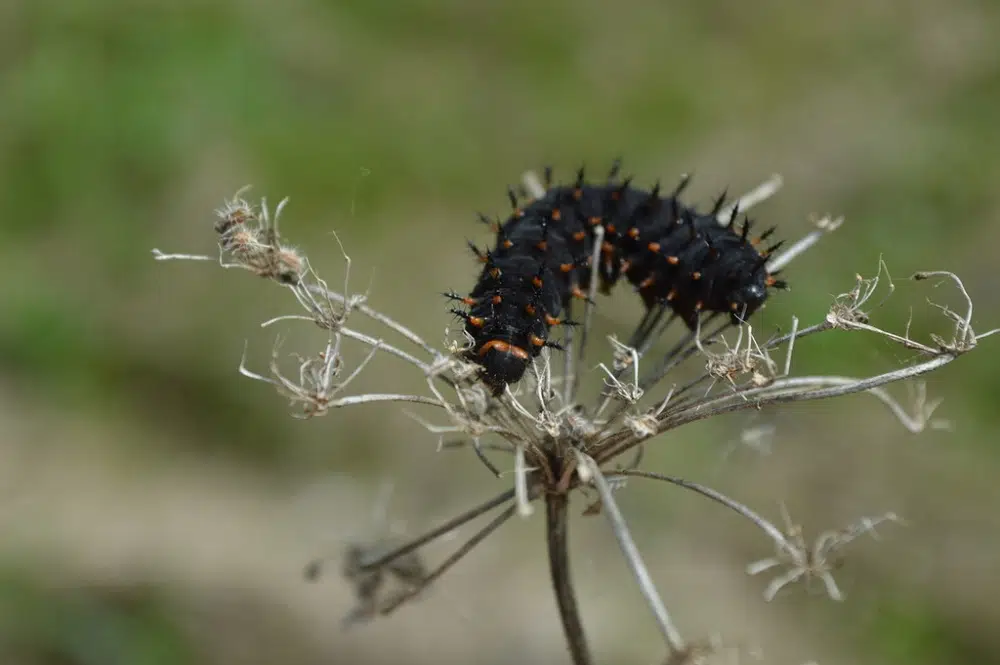
Great Spangled Fritillary caterpillar (Speyeria cybele) has the same colors as adult moths of the species. These colors are black, brown, yellow, and white.
A striped body characterizes this caterpillar. Black and brown interrupted stripes are seen on its dorsal.
Small white dots are also distinguished on the central area of the dorsum.
This species is among the caterpillars that only feed on a particular type of plant. Violets are the host plant of the Great Spangled Fritillary caterpillar.
Michigan is home to a wide range of violets. This includes Sand violet, Prairie violet, and Kidney-leaved violet.
Open areas with sufficient moisture tend to be the ideal habitat for these flowers and the caterpillar.
Milkweeds and thistles replace violets as favorite foods for adult Green Spangled Fritillary moths.
22. Ailanthus Webworm Moth Caterpillar
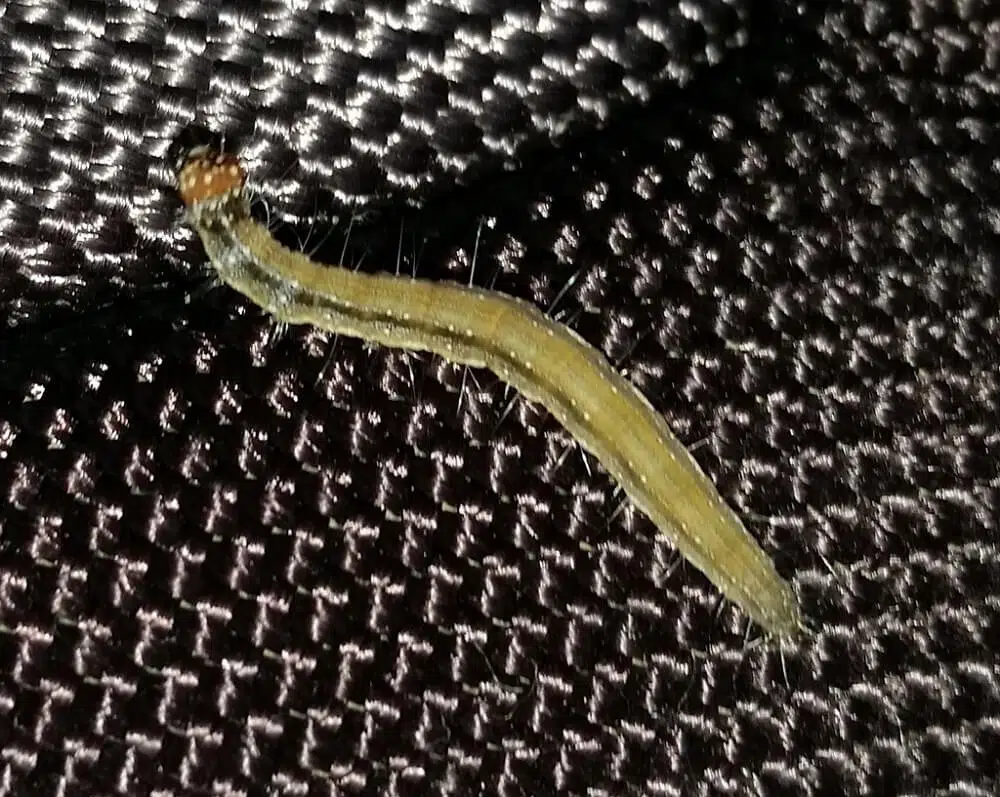
This type of caterpillar (Atteva aurea) is only seen on invasive trees in the state such as the Tree of Heaven.
Known for its Asian origin, this tree has distinct thin green leaves caterpillars and adults of this species like to live on.
The feeding mechanism of the caterpillar is specific to this tree. Without wide leaves, caterpillars pull multiple green leaves together so that they can eat them without moving too much.
You can identify these caterpillars by their dark, almost black color.
Dark brown and black alternating bands are specific to this species. Only a few tiny white dots are further visible behind the head of the caterpillar.
23. Eastern Tent Caterpillar Moth Caterpillar

Caterpillars of this species (Malacosoma americana) build tent-like structures around leaves, similar to the Ailanthus Webworm.
These caterpillars are known for living together up to the final instar.
Tent-like silk structures are built around leaves. Inside, multiple caterpillars feed on these leaves for at least 4 weeks.
Once they reach the final instar, caterpillars get out of the tent and look for a place to pupate.
Caterpillars of the species have colorful bodies. A light brown color is dominant.
The upper dorsum shows a bright yellow stripe. Its sides are where you can see different blue dots with black margins.
Short white hairs are seen across the lower parts of its sides as well.
These caterpillars might only be seen for a few days out of the silk tent before pupation.
24. Northern Pearly-Eye Caterpillar
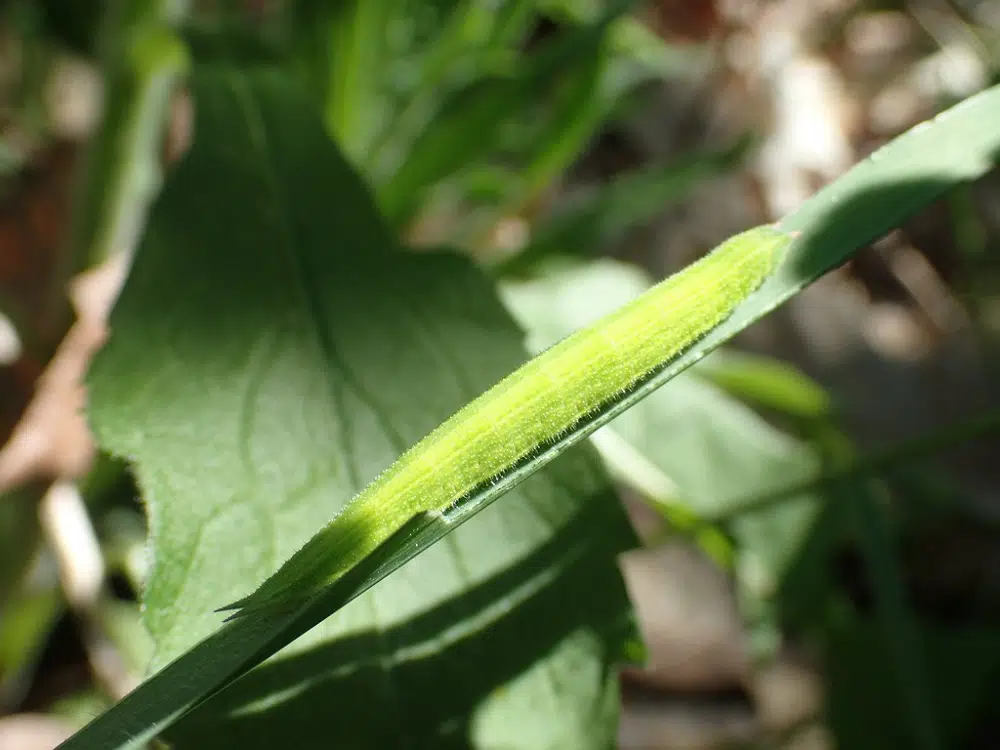
You can identify Northern Pearly-Eye caterpillars (Lethe anthedon) by their bright green coloring.
This species has a distinct green head with orange-red ear-like spikes.
Small white hairs cover almost the entire body of the species.
This green color helps the caterpillar remain undetected for much of its life, especially when it doesn’t move as it lives on wild green grasses.
Some of the grasses the caterpillar eats include bearded shortgrass and bottlebrush grass.
These are small shrub-like grasses that are known to feed a wider range of caterpillars and ants. The impact on these grasses is minimum.
25. Little Wood Satyr Caterpillar
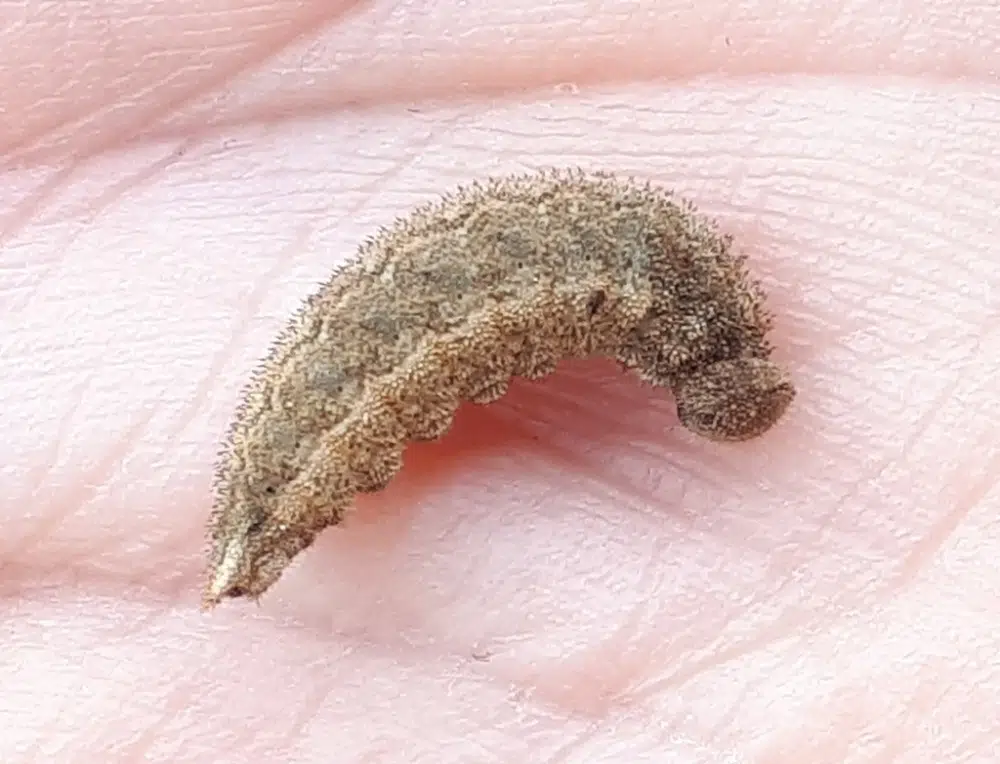
Little Woody Satyr caterpillars (Megisto cymela) are a common sight across multiple areas of the state.
These caterpillars are highly common since they feed on common grasses such as orchardgrass.
You can identify the species by its brown and black color, similar to the coloring of adult moths.
A dark brown color is specific to these caterpillars, together with lateral black bands and white or yellow stripes on the central dorsal area.
Interestingly, the caterpillar remains attracted to feeding on these grasses as an adult. The Little Wood Satyr moth doesn’t like pollen as much as other moths.
Adults of the species feed on plant sap or sugary honeydew coming from aphids.
The species maintain these eating habits all across its extended range in the Eastern United States.
26. Virginian Tiger Moth Caterpillar

This caterpillar comes in different colors depending on its instars or growth periods.
It can be orange, yellow, or brown. The head of the caterpillar typically has a different darker color.
Virginian Tiger Moth caterpillars (Spilosoma virginica) are known for their impact on grasses and clovers.
The impact of the species is only seen at the end of the summer when the second broad is born.
Caterpillars of this genus may also affect certain crops, but they mainly feed on grasses.
The damage seen at the end of the summer can be severe. Entire host plant leaves are consumed by these caterpillars.
27. Viceroy Caterpillar

Viceroy caterpillars (Limenitis archippus) are a brown-black species seen in riparian zones in Michigan.
The caterpillar has a dark brown color which becomes almost black in its last instar.
Viceroy caterpillars have a dark brown color with a white band on the back once they reach their final instar.
Willow leaves are the main food for the species. These caterpillars emerge in the spring on willows.
They feed for at least 3-4 weeks and up to 6 weeks in some cases before pupation.
There are no major similarities between the feeding habits of the Viceroy caterpillar and the Viceroy butterfly.
The adult butterfly feeds on fruit and even animal feces and it doesn’t feed on willows.
28. Baltimore Checkerspot Caterpillar
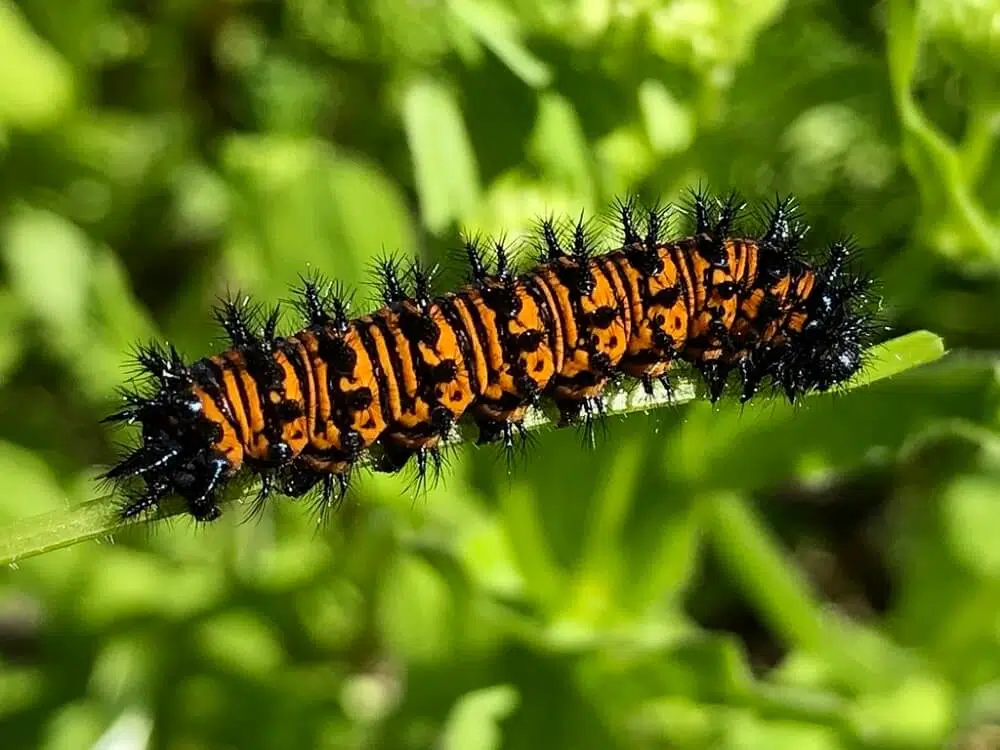
Baltimore Checkerspot caterpillars (Euphydryas phaeton) share some of their physical traits with the adult moth of the species.
The main color of both the moth and the caterpillar is black with brown as a secondary color.
Baltimore Checkerspot caterpillars have a striped body with alternating black and brown stripes.
Black bristle-like hairs are also seen all across its body.
This species is mostly seen on plants such as turtlehead. As an adult, it can continue feeding on the nectar of this plant or move along to other species such as arrowwood.
29. Eastern Giant Swallowtail Caterpillar

Eastern Giant Swallowtail caterpillars (Papilio cresphontes) resemble many swallowtail species in appearance.
Its mimicry efforts make it out to resemble bird droppings. Its color changes through the instars but still varies between different shades of brown.
Eastern Giant Swallowtail caterpillars are among the most common species that use camouflage as a defensive mechanism.
This species has few natural predators and can create large leave damages to its host plants.
Eastern Giant Swallowtails aren’t as big of a pest in Michigan as in other states as they mostly feed on plants of the citrus genus.
Sweet oranges and Northern prickly-ash are among the most common citrus genus plants the Eastern Giant Swallowtail caterpillar feeds on.
30. Giant Leopard Moth Caterpillar

The Giant Leopard Moth caterpillar (Hypercompe scribonia) gets its name from the leopard-looking moth of the species.
Known for its leopard print, the moth has a similar-looking caterpillar which has a combination of brown and black colors and long black hairs.
This specie is a considerable pest in some states. Its negative impact isn’t as large on plants in Michigan as it prefers to defoliate plants that grow in other states more.
Cabbage is among the most impacted vegetables when it comes to the eating habits of the Giant Leopard Moth caterpillar.
In other areas, this caterpillar also feeds on the leaves of lemons, bananas, and avocados.
31. American Copper Underwing Caterpillar
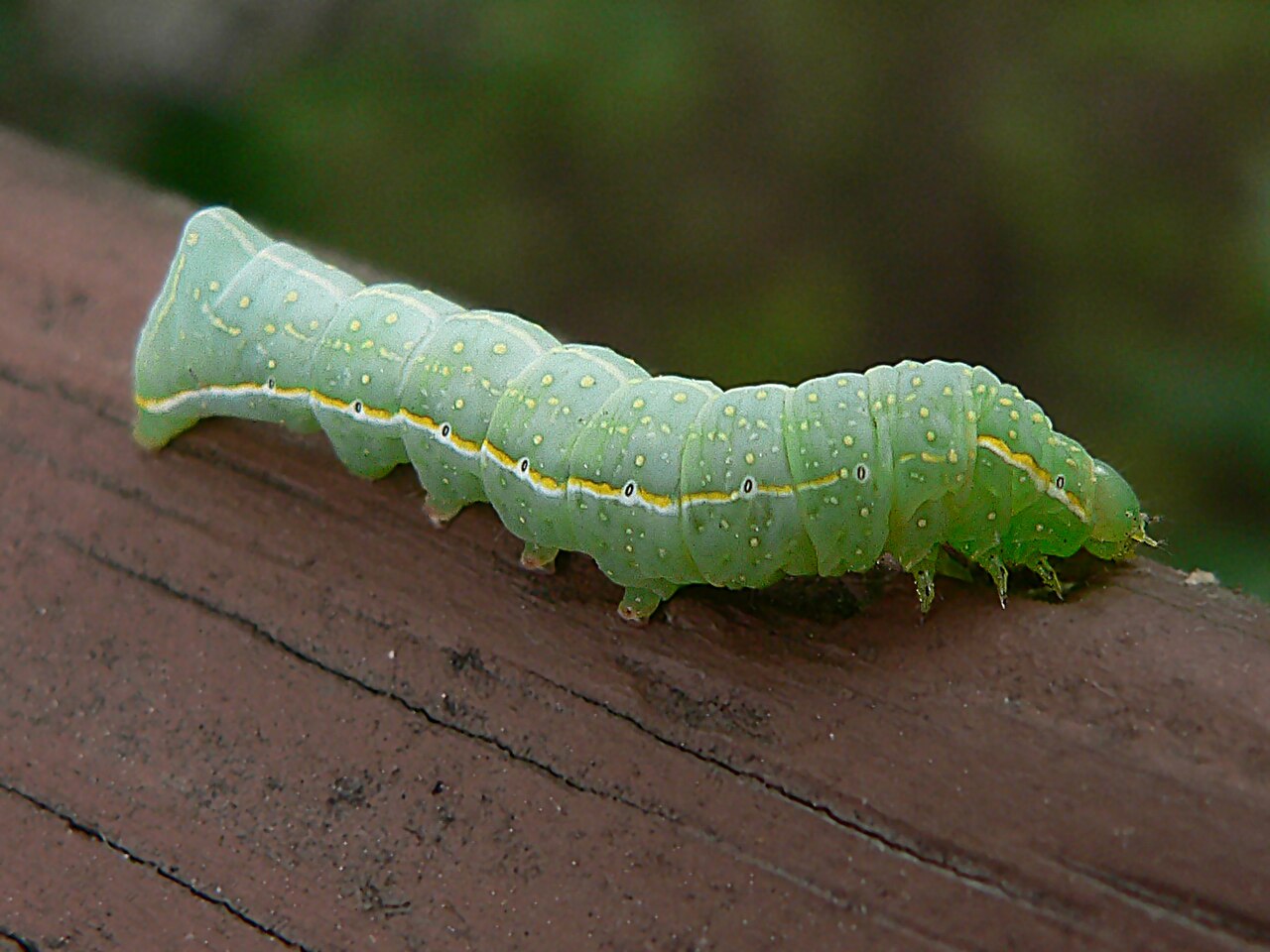
The negative impact of the American Copper Underwing caterpillar (Amphipyra pyramidoides) can be considered in the state.
It feeds on a wide range of shrubs and trees to the extent it chews entire leaves impacting photosynthesis.
The American Copper Underwing caterpillar has a uniform green color. This color is specific to many generalist caterpillars that feed on multiple species.
Caterpillars of this genus are known for their impact on certain trees such as ash, oak, and apple. All of these trees grow in Michigan.
Some research also suggests the American Copper Underwing caterpillar is highly attracted to sugar and sweet substances.
This is why it’s also found in many habitats with aphids.
The caterpillar can further feed on honeysuckle as a result.
32. Fall Webworm
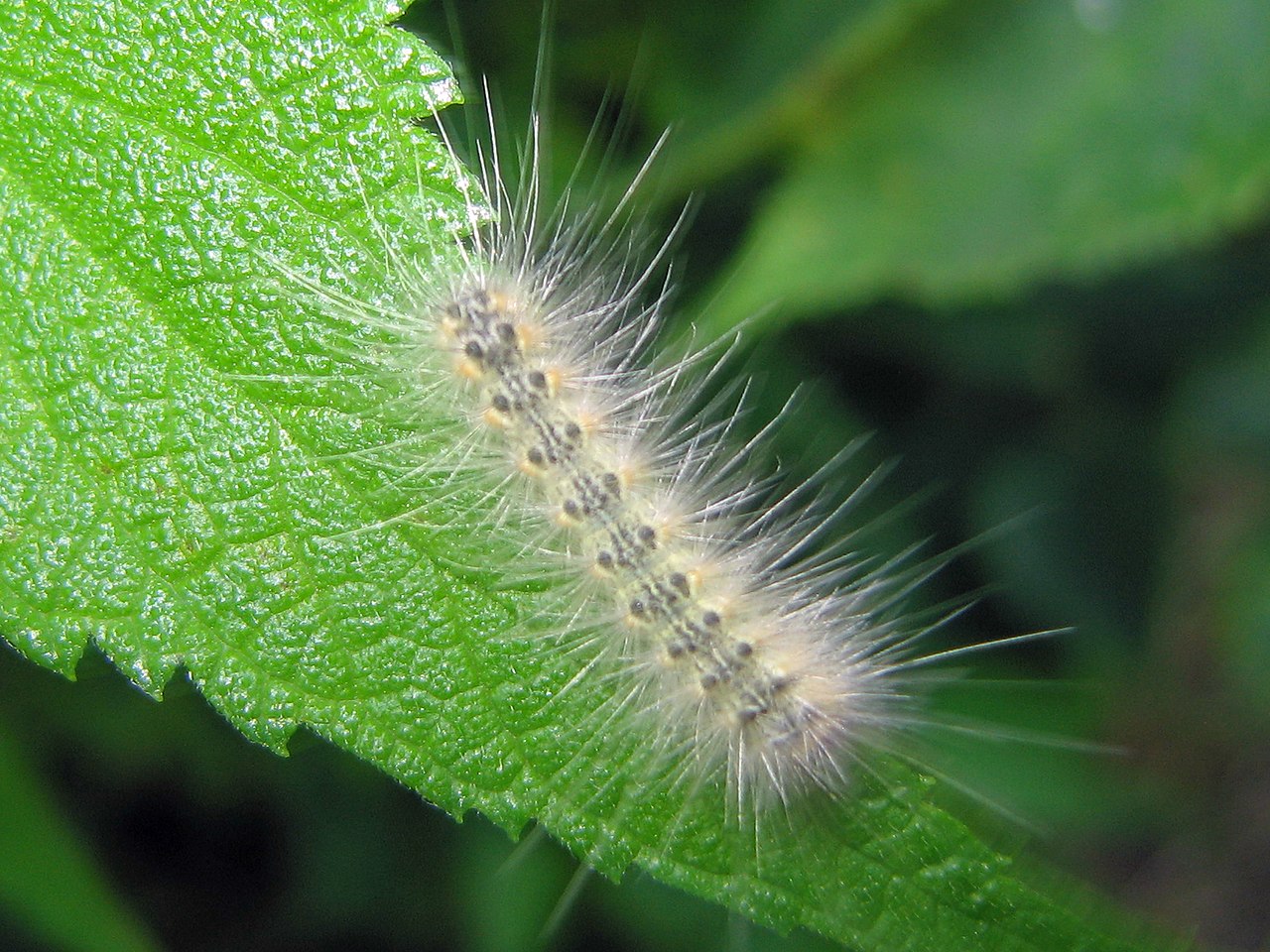
Fall Webworms (Hyphantria cunea) are among the most common species of caterpillars that feed on willow.
Michigan is a state known for its large number of caterpillars that live and eat willow leaves.
However, Fall Webworms have a very large impact on these trees as they live together in nests made from caterpillar web.
These caterpillars create these nests right on the branches of willows. Some comparative studies note that the tips of the branches are preferred to the base of branches for creating the caterpillar web.
One of the interesting facts about these caterpillars is they manage to synchronize their movements when the caterpillar web is shaken.
It’s the shaking that gets rid of all of the excess leaves leaving only healthy leaves for the caterpillars to feed on.
Nobody knows for sure how Fall Webworms manage to move together at once.
However, given the species lives socially and given willow is already seen as a host tree by other species might also be one of the reasons many willow trees can suffer in health from leaf damage.
33. Pale Beauty Caterpillar

The Pale Beauty caterpillar (Campaea perlata) is the young version of the green leaf-like adult Pale Beauty.
Caterpillars of this species have a brown body color which can show black marks or spots.
These caterpillars are always seen across old forests in the state.
As they grow, these caterpillars can spread through the forest, typically on trees of the same genus.
These caterpillars love to eat oak or poplar leaves.
They can also migrate to willow, a common species for caterpillars to feed on.
Alder and ash trees might also suffer from the presence of the species, but not to a hazardous level.
34. Eastern Comma Caterpillar
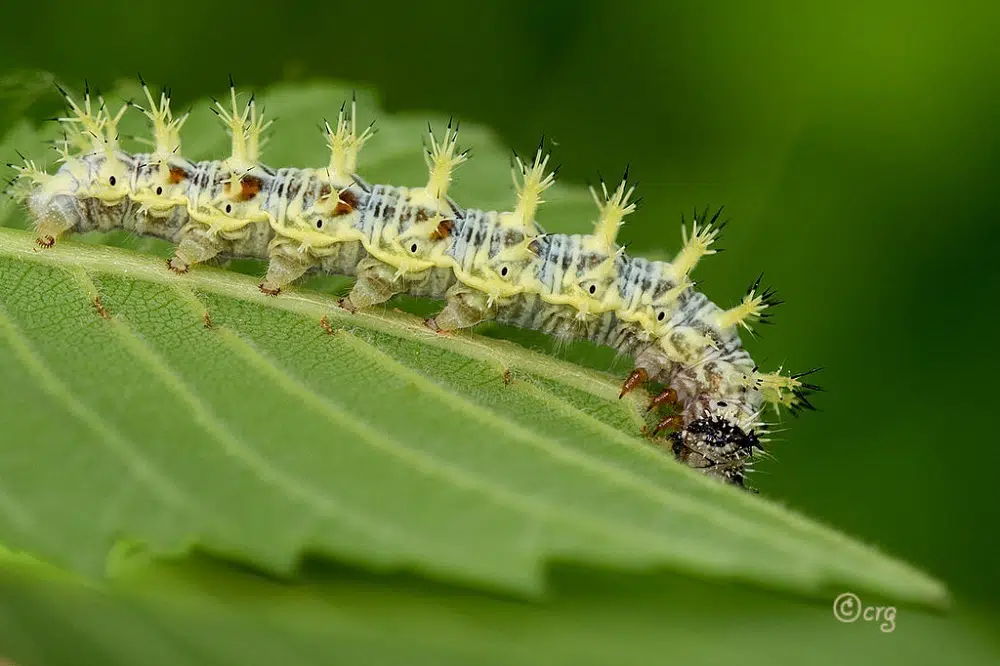
The Eastern Comma caterpillar (Polygonia comma) is one of the species that grows on hemp.
Caterpillars of this genus have a few different other hosts which include nettle species. This means it has few natural predators.
You can identify this species by its black and white body. The caterpillar has black and white stripes and long black hairs.
The size of the species can vary. However, the largest Eastern Comma caterpillar rarely measures more than 1.2 inches.
35. Large Yellow Underwing Caterpillar

The Large Yellow Underwing caterpillar (Noctua pronuba) comes in many colors. Its final instar coloring is made from a combination of green, yellow, brown, and black stripes.
The ventral side of the species has a uniform brown color.
You can see the Large Yellow Underwing caterpillar in various open lands across the state. The species is also common in gardens, parks, and meadows.
The impact of the caterpillar on its host plants can be considerable given its large size and the small size of the host plants.
Large Yellow Underwing caterpillars are mostly seen on foxgloves and marigolds.
36. Painted Lady Caterpillar
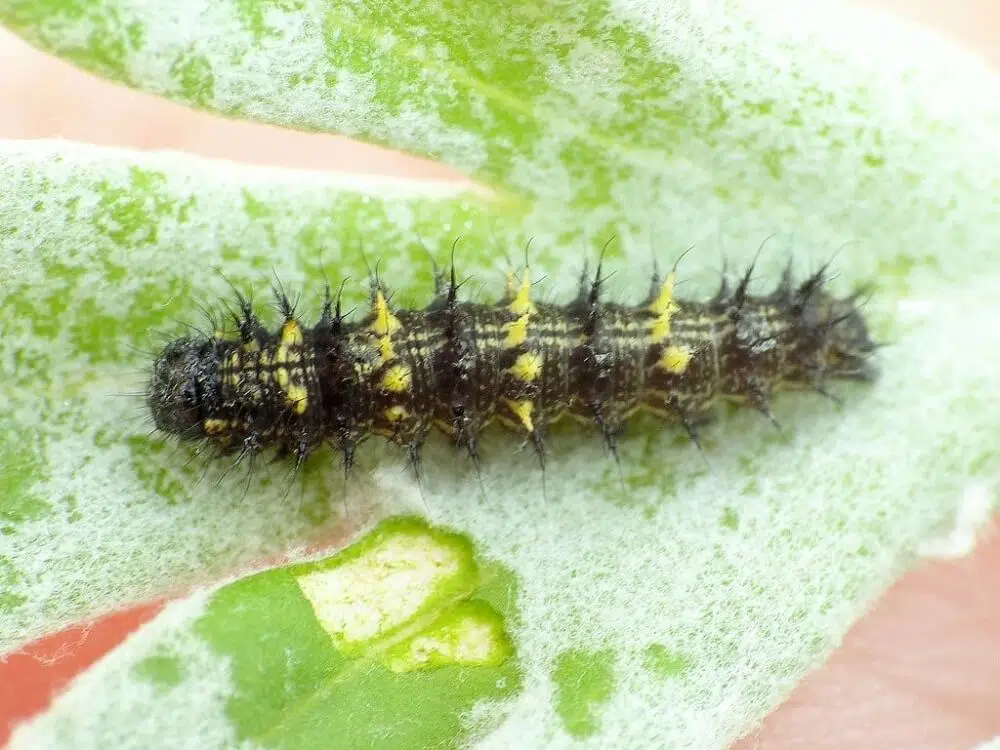
Painted Lady caterpillars (Vanessa cardui) have a mostly black body with golden-yellow lines and small white dots.
It leaves on many hosts. Up to 100 hosts are found in the state for this species.
Asters are among the common flowers caterpillars and adult Painted Ladies are seen on.
The caterpillars of the species are also known for living in nets. They build silk-like nest structures around the leaves of their hosts.
37. Canadian Tiger Swallowtail Caterpillar

When it comes to caterpillars in Michigan, most are species also found in other Eastern US states.
Canadian Tiger Swallowtail caterpillars (Papilio canadensis) are an exception. These caterpillars are mostly found in the Northern parts of the state as they are native to Canada.
Accustomed to cold winter climates and mild summers, these caterpillars are known for their preference for certain trees.
They’re a common pest of poplars and birches. They also feed on fruit trees such as apple and cherry trees.